Holmes Institute HA2011: Management Accounting Report on Telstra
VerifiedAdded on 2023/03/23
|13
|3838
|93
Report
AI Summary
This report delves into the application of management accounting principles, specifically focusing on the value chain concept and its practical implementation within Telstra, a prominent Australian telecommunications company. The executive summary provides an overview of the report's core content, including the explanation of the value chain and its significance for organizational development, followed by a case study analysis of Telstra's competitive strategies through the lens of the value chain model. The report further explores the primary and support activities within Telstra's value chain, such as inbound logistics, operations, outbound logistics, sales and marketing, and service. Moreover, it examines Telstra's competitive advantages, particularly in cost leadership, and applies various value chain concepts to describe Telstra's current market position. The report also includes a discussion on value-adding processes, like technological development and human resource management, and their impact on the company's performance. Additionally, the report addresses specific accounting questions, including overhead cost allocation and total cost calculations within a job costing context. Finally, the report concludes with a comprehensive analysis of Telstra's value chain model, offering insights into its operations, competitive advantages, and strategic initiatives.
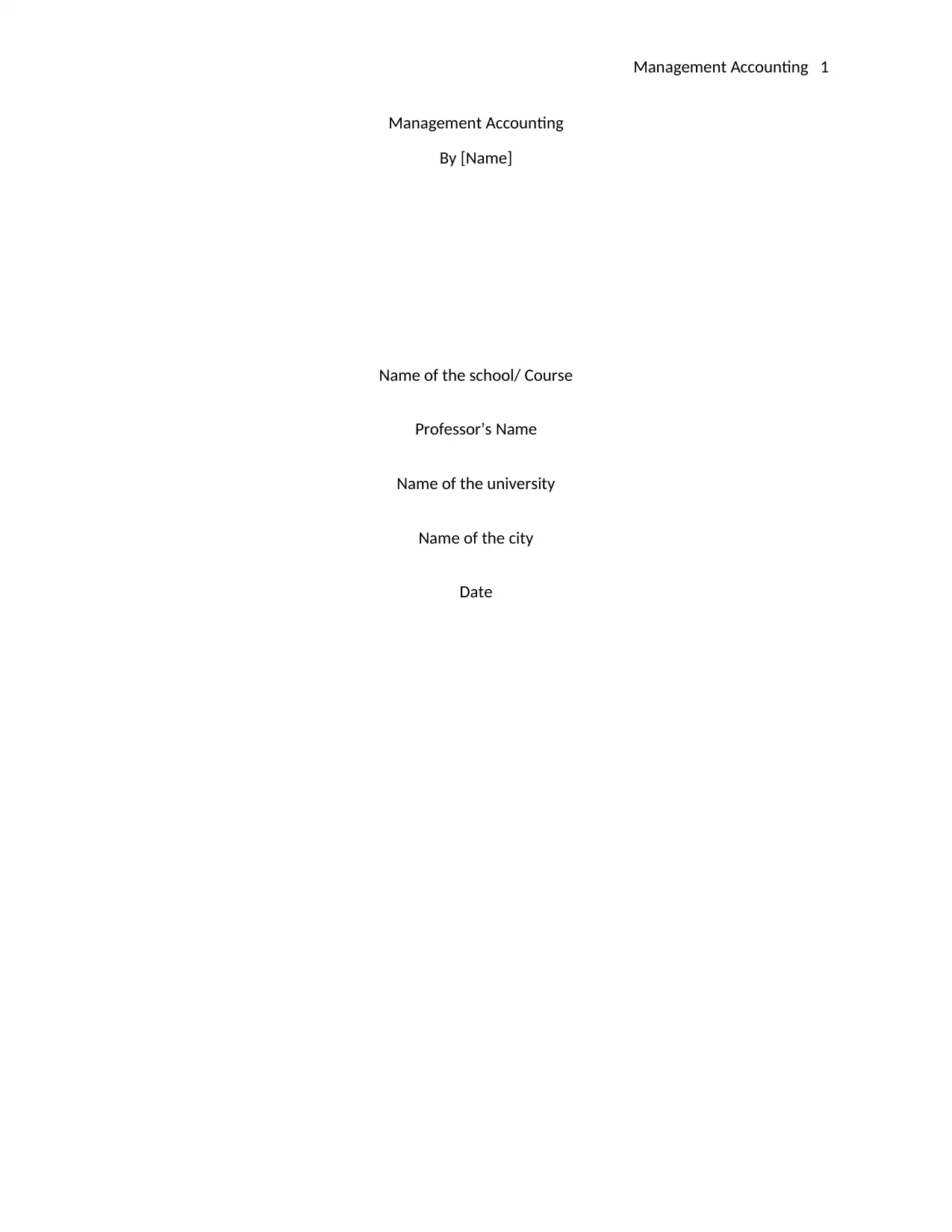
Management Accounting 1
Management Accounting
By [Name]
Name of the school/ Course
Professor’s Name
Name of the university
Name of the city
Date
Management Accounting
By [Name]
Name of the school/ Course
Professor’s Name
Name of the university
Name of the city
Date
Paraphrase This Document
Need a fresh take? Get an instant paraphrase of this document with our AI Paraphraser
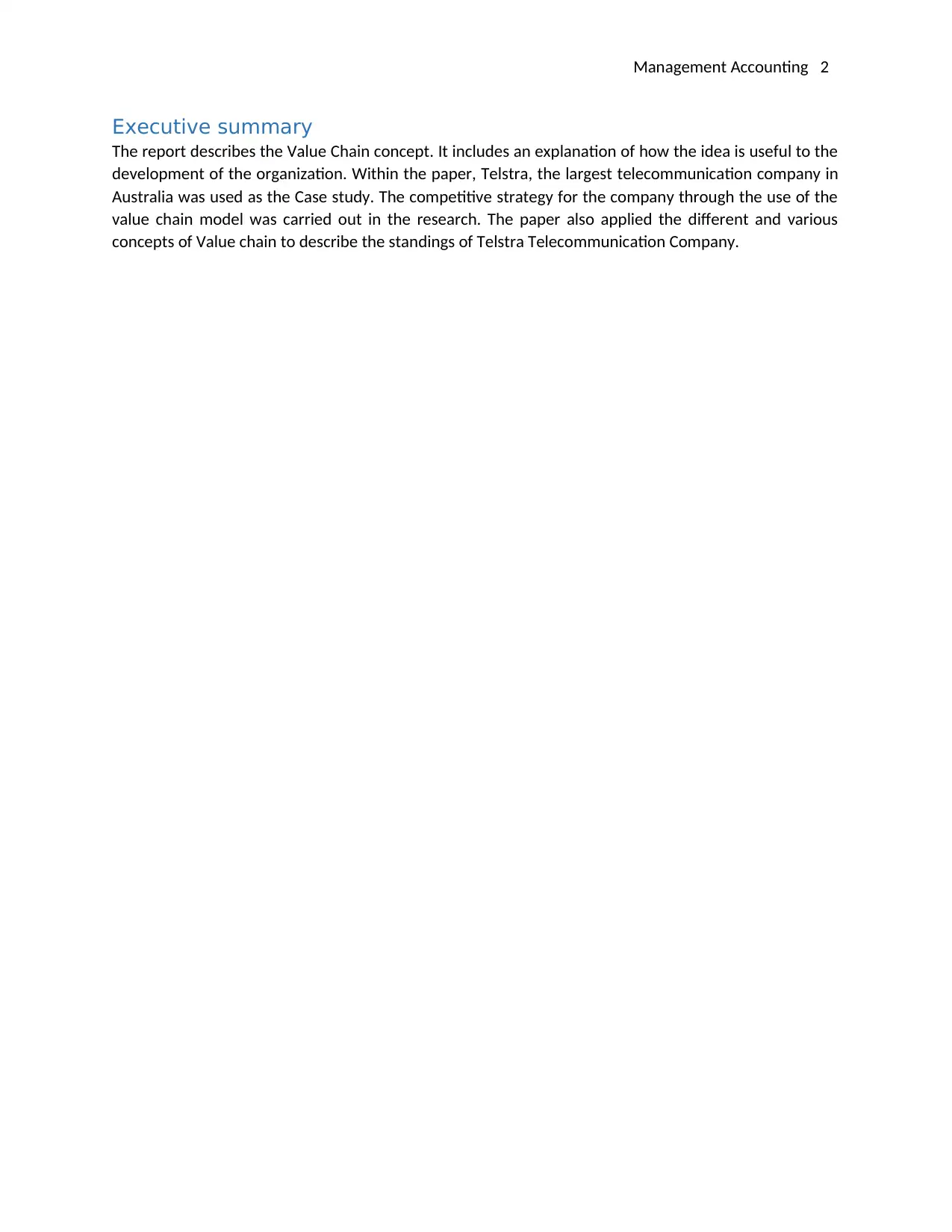
Management Accounting 2
Executive summary
The report describes the Value Chain concept. It includes an explanation of how the idea is useful to the
development of the organization. Within the paper, Telstra, the largest telecommunication company in
Australia was used as the Case study. The competitive strategy for the company through the use of the
value chain model was carried out in the research. The paper also applied the different and various
concepts of Value chain to describe the standings of Telstra Telecommunication Company.
Executive summary
The report describes the Value Chain concept. It includes an explanation of how the idea is useful to the
development of the organization. Within the paper, Telstra, the largest telecommunication company in
Australia was used as the Case study. The competitive strategy for the company through the use of the
value chain model was carried out in the research. The paper also applied the different and various
concepts of Value chain to describe the standings of Telstra Telecommunication Company.
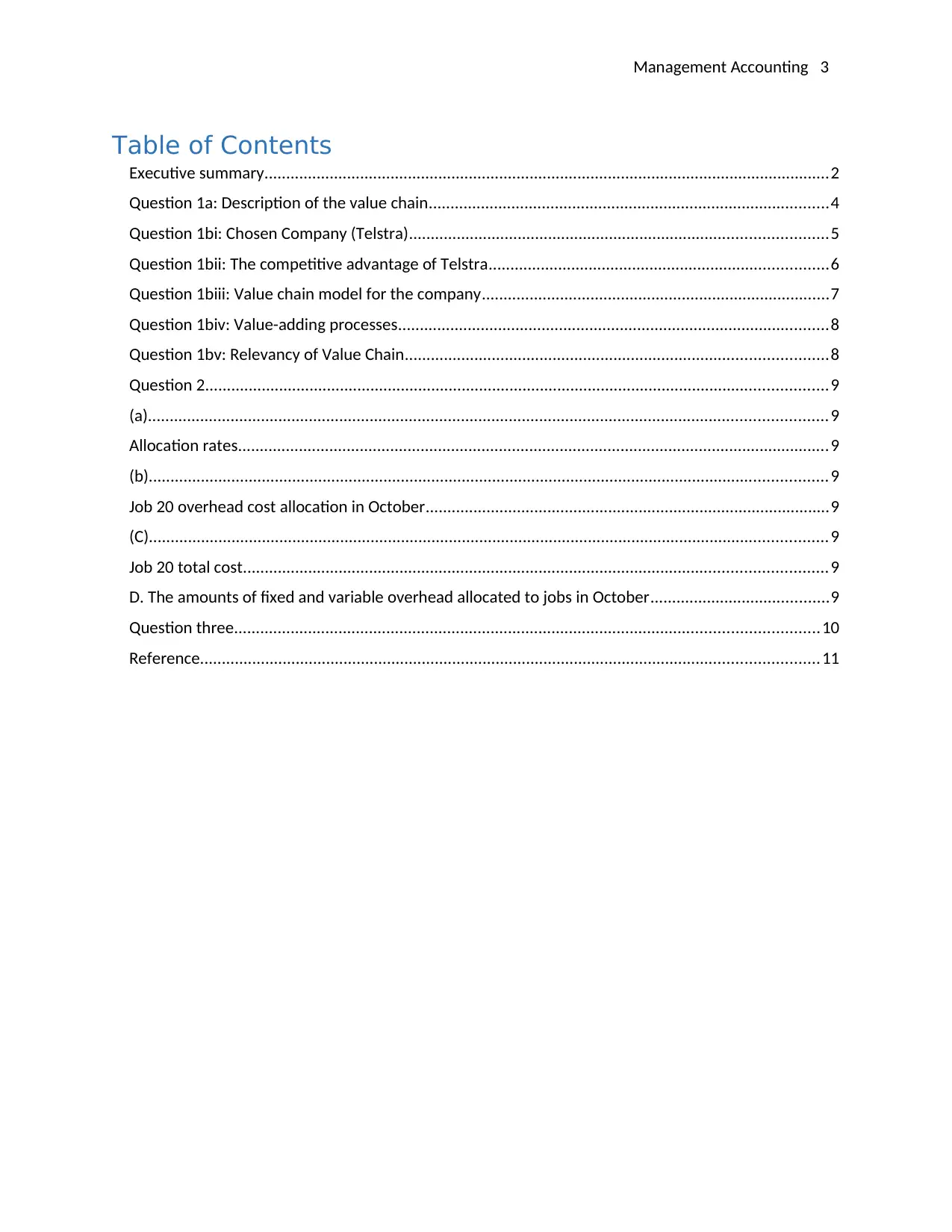
Management Accounting 3
Table of Contents
Executive summary..................................................................................................................................2
Question 1a: Description of the value chain............................................................................................4
Question 1bi: Chosen Company (Telstra)................................................................................................5
Question 1bii: The competitive advantage of Telstra..............................................................................6
Question 1biii: Value chain model for the company................................................................................7
Question 1biv: Value-adding processes...................................................................................................8
Question 1bv: Relevancy of Value Chain.................................................................................................8
Question 2...............................................................................................................................................9
(a)............................................................................................................................................................9
Allocation rates........................................................................................................................................9
(b)............................................................................................................................................................9
Job 20 overhead cost allocation in October.............................................................................................9
(C)............................................................................................................................................................9
Job 20 total cost......................................................................................................................................9
D. The amounts of fixed and variable overhead allocated to jobs in October.........................................9
Question three......................................................................................................................................10
Reference..............................................................................................................................................11
Table of Contents
Executive summary..................................................................................................................................2
Question 1a: Description of the value chain............................................................................................4
Question 1bi: Chosen Company (Telstra)................................................................................................5
Question 1bii: The competitive advantage of Telstra..............................................................................6
Question 1biii: Value chain model for the company................................................................................7
Question 1biv: Value-adding processes...................................................................................................8
Question 1bv: Relevancy of Value Chain.................................................................................................8
Question 2...............................................................................................................................................9
(a)............................................................................................................................................................9
Allocation rates........................................................................................................................................9
(b)............................................................................................................................................................9
Job 20 overhead cost allocation in October.............................................................................................9
(C)............................................................................................................................................................9
Job 20 total cost......................................................................................................................................9
D. The amounts of fixed and variable overhead allocated to jobs in October.........................................9
Question three......................................................................................................................................10
Reference..............................................................................................................................................11
⊘ This is a preview!⊘
Do you want full access?
Subscribe today to unlock all pages.

Trusted by 1+ million students worldwide
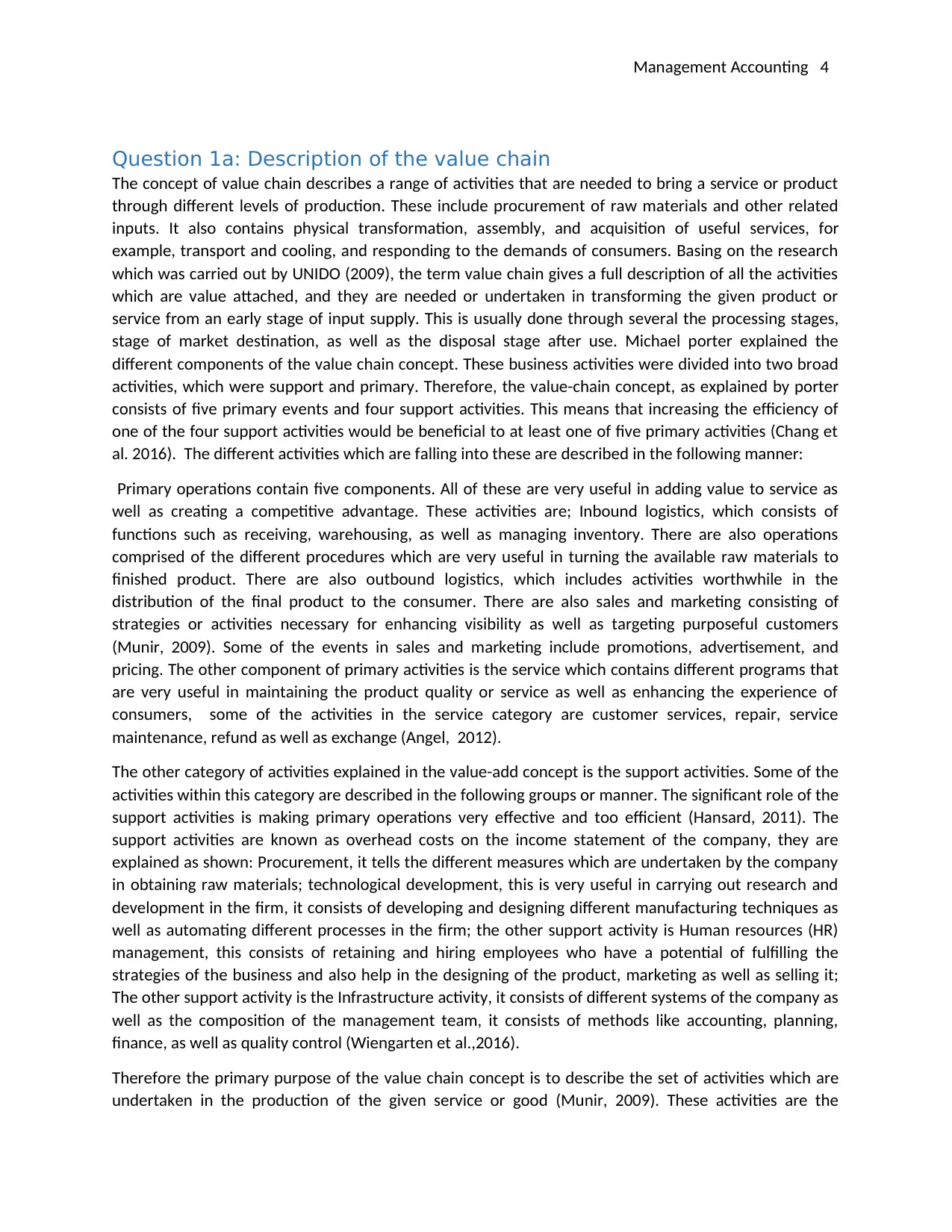
Management Accounting 4
Question 1a: Description of the value chain
The concept of value chain describes a range of activities that are needed to bring a service or product
through different levels of production. These include procurement of raw materials and other related
inputs. It also contains physical transformation, assembly, and acquisition of useful services, for
example, transport and cooling, and responding to the demands of consumers. Basing on the research
which was carried out by UNIDO (2009), the term value chain gives a full description of all the activities
which are value attached, and they are needed or undertaken in transforming the given product or
service from an early stage of input supply. This is usually done through several the processing stages,
stage of market destination, as well as the disposal stage after use. Michael porter explained the
different components of the value chain concept. These business activities were divided into two broad
activities, which were support and primary. Therefore, the value-chain concept, as explained by porter
consists of five primary events and four support activities. This means that increasing the efficiency of
one of the four support activities would be beneficial to at least one of five primary activities (Chang et
al. 2016). The different activities which are falling into these are described in the following manner:
Primary operations contain five components. All of these are very useful in adding value to service as
well as creating a competitive advantage. These activities are; Inbound logistics, which consists of
functions such as receiving, warehousing, as well as managing inventory. There are also operations
comprised of the different procedures which are very useful in turning the available raw materials to
finished product. There are also outbound logistics, which includes activities worthwhile in the
distribution of the final product to the consumer. There are also sales and marketing consisting of
strategies or activities necessary for enhancing visibility as well as targeting purposeful customers
(Munir, 2009). Some of the events in sales and marketing include promotions, advertisement, and
pricing. The other component of primary activities is the service which contains different programs that
are very useful in maintaining the product quality or service as well as enhancing the experience of
consumers, some of the activities in the service category are customer services, repair, service
maintenance, refund as well as exchange (Angel, 2012).
The other category of activities explained in the value-add concept is the support activities. Some of the
activities within this category are described in the following groups or manner. The significant role of the
support activities is making primary operations very effective and too efficient (Hansard, 2011). The
support activities are known as overhead costs on the income statement of the company, they are
explained as shown: Procurement, it tells the different measures which are undertaken by the company
in obtaining raw materials; technological development, this is very useful in carrying out research and
development in the firm, it consists of developing and designing different manufacturing techniques as
well as automating different processes in the firm; the other support activity is Human resources (HR)
management, this consists of retaining and hiring employees who have a potential of fulfilling the
strategies of the business and also help in the designing of the product, marketing as well as selling it;
The other support activity is the Infrastructure activity, it consists of different systems of the company as
well as the composition of the management team, it consists of methods like accounting, planning,
finance, as well as quality control (Wiengarten et al.,2016).
Therefore the primary purpose of the value chain concept is to describe the set of activities which are
undertaken in the production of the given service or good (Munir, 2009). These activities are the
Question 1a: Description of the value chain
The concept of value chain describes a range of activities that are needed to bring a service or product
through different levels of production. These include procurement of raw materials and other related
inputs. It also contains physical transformation, assembly, and acquisition of useful services, for
example, transport and cooling, and responding to the demands of consumers. Basing on the research
which was carried out by UNIDO (2009), the term value chain gives a full description of all the activities
which are value attached, and they are needed or undertaken in transforming the given product or
service from an early stage of input supply. This is usually done through several the processing stages,
stage of market destination, as well as the disposal stage after use. Michael porter explained the
different components of the value chain concept. These business activities were divided into two broad
activities, which were support and primary. Therefore, the value-chain concept, as explained by porter
consists of five primary events and four support activities. This means that increasing the efficiency of
one of the four support activities would be beneficial to at least one of five primary activities (Chang et
al. 2016). The different activities which are falling into these are described in the following manner:
Primary operations contain five components. All of these are very useful in adding value to service as
well as creating a competitive advantage. These activities are; Inbound logistics, which consists of
functions such as receiving, warehousing, as well as managing inventory. There are also operations
comprised of the different procedures which are very useful in turning the available raw materials to
finished product. There are also outbound logistics, which includes activities worthwhile in the
distribution of the final product to the consumer. There are also sales and marketing consisting of
strategies or activities necessary for enhancing visibility as well as targeting purposeful customers
(Munir, 2009). Some of the events in sales and marketing include promotions, advertisement, and
pricing. The other component of primary activities is the service which contains different programs that
are very useful in maintaining the product quality or service as well as enhancing the experience of
consumers, some of the activities in the service category are customer services, repair, service
maintenance, refund as well as exchange (Angel, 2012).
The other category of activities explained in the value-add concept is the support activities. Some of the
activities within this category are described in the following groups or manner. The significant role of the
support activities is making primary operations very effective and too efficient (Hansard, 2011). The
support activities are known as overhead costs on the income statement of the company, they are
explained as shown: Procurement, it tells the different measures which are undertaken by the company
in obtaining raw materials; technological development, this is very useful in carrying out research and
development in the firm, it consists of developing and designing different manufacturing techniques as
well as automating different processes in the firm; the other support activity is Human resources (HR)
management, this consists of retaining and hiring employees who have a potential of fulfilling the
strategies of the business and also help in the designing of the product, marketing as well as selling it;
The other support activity is the Infrastructure activity, it consists of different systems of the company as
well as the composition of the management team, it consists of methods like accounting, planning,
finance, as well as quality control (Wiengarten et al.,2016).
Therefore the primary purpose of the value chain concept is to describe the set of activities which are
undertaken in the production of the given service or good (Munir, 2009). These activities are the
Paraphrase This Document
Need a fresh take? Get an instant paraphrase of this document with our AI Paraphraser
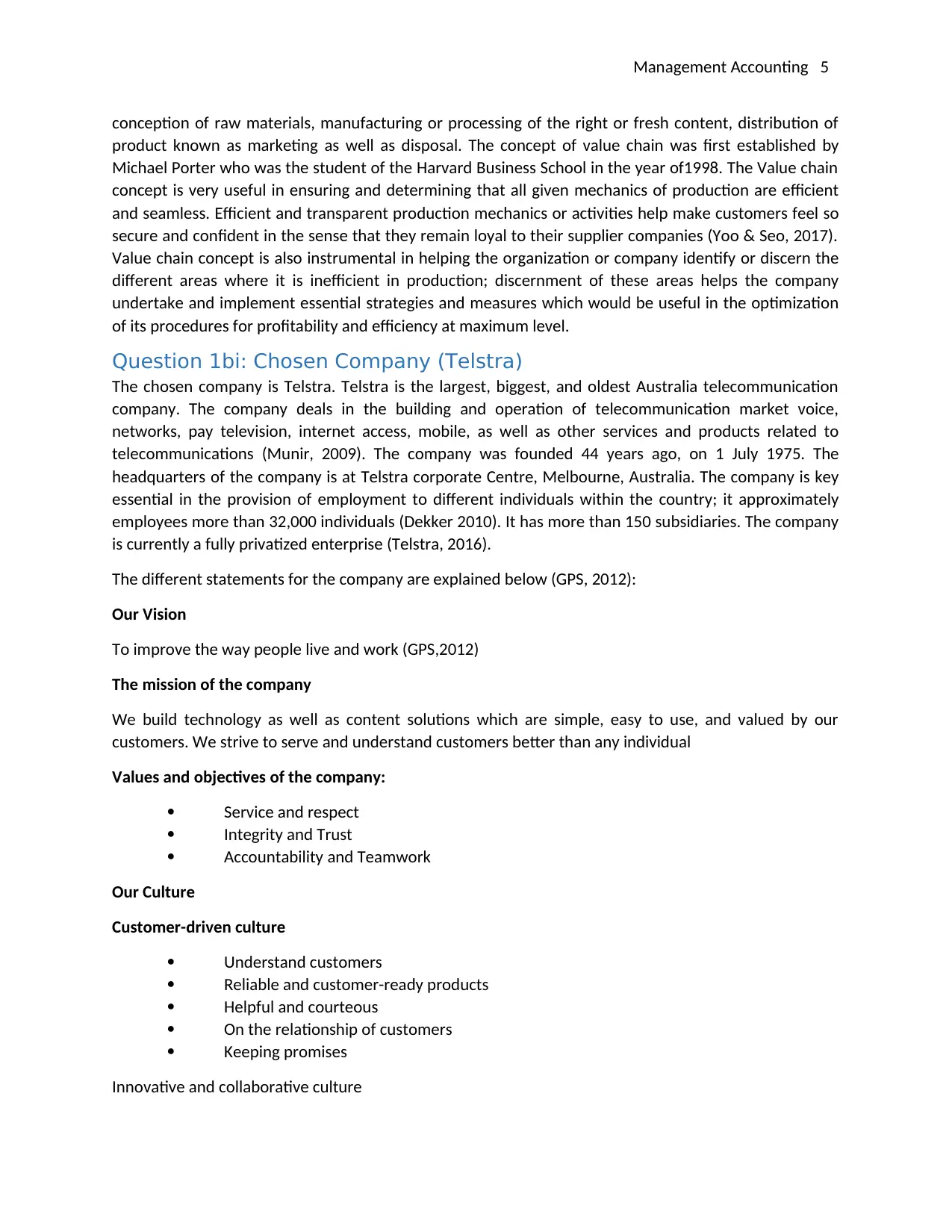
Management Accounting 5
conception of raw materials, manufacturing or processing of the right or fresh content, distribution of
product known as marketing as well as disposal. The concept of value chain was first established by
Michael Porter who was the student of the Harvard Business School in the year of1998. The Value chain
concept is very useful in ensuring and determining that all given mechanics of production are efficient
and seamless. Efficient and transparent production mechanics or activities help make customers feel so
secure and confident in the sense that they remain loyal to their supplier companies (Yoo & Seo, 2017).
Value chain concept is also instrumental in helping the organization or company identify or discern the
different areas where it is inefficient in production; discernment of these areas helps the company
undertake and implement essential strategies and measures which would be useful in the optimization
of its procedures for profitability and efficiency at maximum level.
Question 1bi: Chosen Company (Telstra)
The chosen company is Telstra. Telstra is the largest, biggest, and oldest Australia telecommunication
company. The company deals in the building and operation of telecommunication market voice,
networks, pay television, internet access, mobile, as well as other services and products related to
telecommunications (Munir, 2009). The company was founded 44 years ago, on 1 July 1975. The
headquarters of the company is at Telstra corporate Centre, Melbourne, Australia. The company is key
essential in the provision of employment to different individuals within the country; it approximately
employees more than 32,000 individuals (Dekker 2010). It has more than 150 subsidiaries. The company
is currently a fully privatized enterprise (Telstra, 2016).
The different statements for the company are explained below (GPS, 2012):
Our Vision
To improve the way people live and work (GPS,2012)
The mission of the company
We build technology as well as content solutions which are simple, easy to use, and valued by our
customers. We strive to serve and understand customers better than any individual
Values and objectives of the company:
Service and respect
Integrity and Trust
Accountability and Teamwork
Our Culture
Customer-driven culture
Understand customers
Reliable and customer-ready products
Helpful and courteous
On the relationship of customers
Keeping promises
Innovative and collaborative culture
conception of raw materials, manufacturing or processing of the right or fresh content, distribution of
product known as marketing as well as disposal. The concept of value chain was first established by
Michael Porter who was the student of the Harvard Business School in the year of1998. The Value chain
concept is very useful in ensuring and determining that all given mechanics of production are efficient
and seamless. Efficient and transparent production mechanics or activities help make customers feel so
secure and confident in the sense that they remain loyal to their supplier companies (Yoo & Seo, 2017).
Value chain concept is also instrumental in helping the organization or company identify or discern the
different areas where it is inefficient in production; discernment of these areas helps the company
undertake and implement essential strategies and measures which would be useful in the optimization
of its procedures for profitability and efficiency at maximum level.
Question 1bi: Chosen Company (Telstra)
The chosen company is Telstra. Telstra is the largest, biggest, and oldest Australia telecommunication
company. The company deals in the building and operation of telecommunication market voice,
networks, pay television, internet access, mobile, as well as other services and products related to
telecommunications (Munir, 2009). The company was founded 44 years ago, on 1 July 1975. The
headquarters of the company is at Telstra corporate Centre, Melbourne, Australia. The company is key
essential in the provision of employment to different individuals within the country; it approximately
employees more than 32,000 individuals (Dekker 2010). It has more than 150 subsidiaries. The company
is currently a fully privatized enterprise (Telstra, 2016).
The different statements for the company are explained below (GPS, 2012):
Our Vision
To improve the way people live and work (GPS,2012)
The mission of the company
We build technology as well as content solutions which are simple, easy to use, and valued by our
customers. We strive to serve and understand customers better than any individual
Values and objectives of the company:
Service and respect
Integrity and Trust
Accountability and Teamwork
Our Culture
Customer-driven culture
Understand customers
Reliable and customer-ready products
Helpful and courteous
On the relationship of customers
Keeping promises
Innovative and collaborative culture
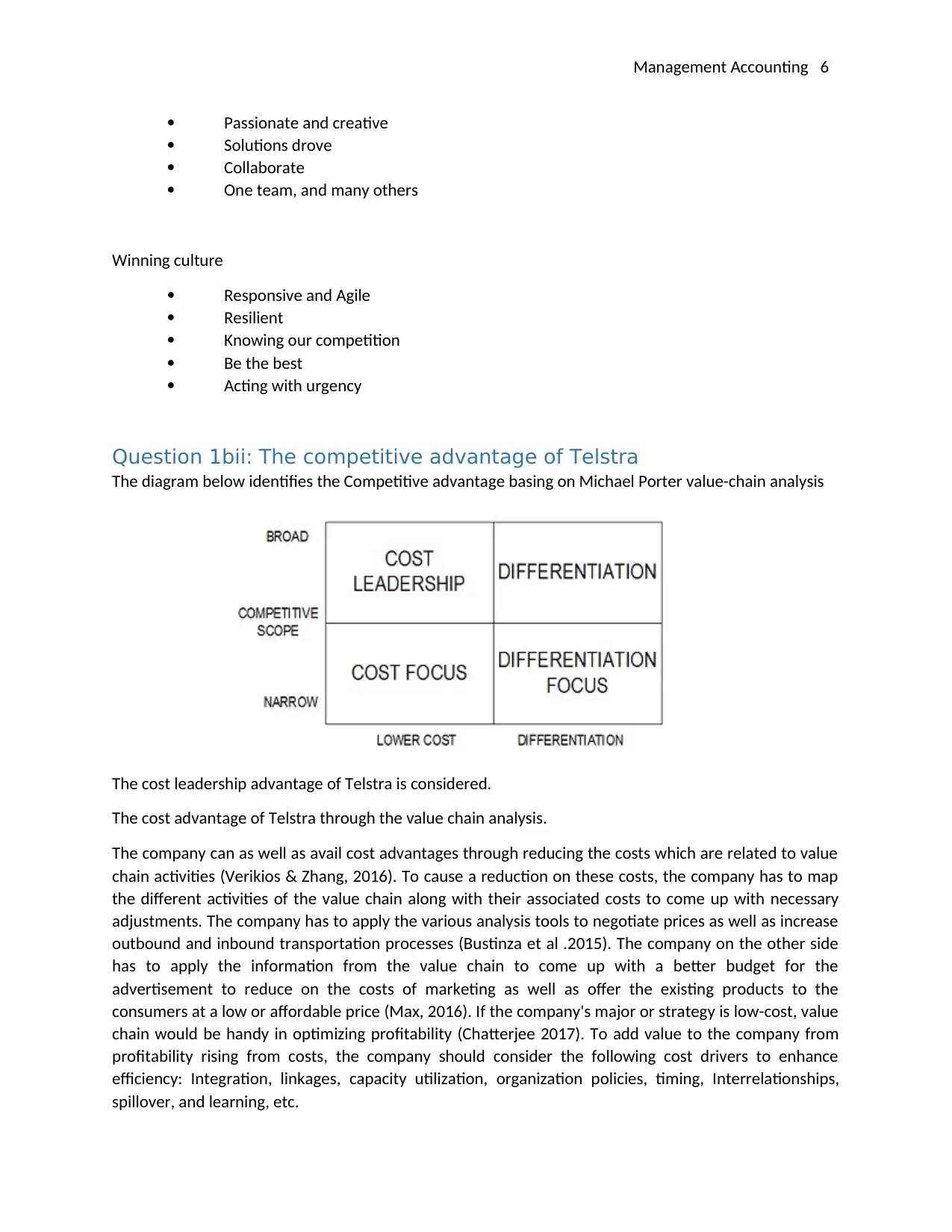
Management Accounting 6
Passionate and creative
Solutions drove
Collaborate
One team, and many others
Winning culture
Responsive and Agile
Resilient
Knowing our competition
Be the best
Acting with urgency
Question 1bii: The competitive advantage of Telstra
The diagram below identifies the Competitive advantage basing on Michael Porter value-chain analysis
The cost leadership advantage of Telstra is considered.
The cost advantage of Telstra through the value chain analysis.
The company can as well as avail cost advantages through reducing the costs which are related to value
chain activities (Verikios & Zhang, 2016). To cause a reduction on these costs, the company has to map
the different activities of the value chain along with their associated costs to come up with necessary
adjustments. The company has to apply the various analysis tools to negotiate prices as well as increase
outbound and inbound transportation processes (Bustinza et al .2015). The company on the other side
has to apply the information from the value chain to come up with a better budget for the
advertisement to reduce on the costs of marketing as well as offer the existing products to the
consumers at a low or affordable price (Max, 2016). If the company's major or strategy is low-cost, value
chain would be handy in optimizing profitability (Chatterjee 2017). To add value to the company from
profitability rising from costs, the company should consider the following cost drivers to enhance
efficiency: Integration, linkages, capacity utilization, organization policies, timing, Interrelationships,
spillover, and learning, etc.
Passionate and creative
Solutions drove
Collaborate
One team, and many others
Winning culture
Responsive and Agile
Resilient
Knowing our competition
Be the best
Acting with urgency
Question 1bii: The competitive advantage of Telstra
The diagram below identifies the Competitive advantage basing on Michael Porter value-chain analysis
The cost leadership advantage of Telstra is considered.
The cost advantage of Telstra through the value chain analysis.
The company can as well as avail cost advantages through reducing the costs which are related to value
chain activities (Verikios & Zhang, 2016). To cause a reduction on these costs, the company has to map
the different activities of the value chain along with their associated costs to come up with necessary
adjustments. The company has to apply the various analysis tools to negotiate prices as well as increase
outbound and inbound transportation processes (Bustinza et al .2015). The company on the other side
has to apply the information from the value chain to come up with a better budget for the
advertisement to reduce on the costs of marketing as well as offer the existing products to the
consumers at a low or affordable price (Max, 2016). If the company's major or strategy is low-cost, value
chain would be handy in optimizing profitability (Chatterjee 2017). To add value to the company from
profitability rising from costs, the company should consider the following cost drivers to enhance
efficiency: Integration, linkages, capacity utilization, organization policies, timing, Interrelationships,
spillover, and learning, etc.
⊘ This is a preview!⊘
Do you want full access?
Subscribe today to unlock all pages.

Trusted by 1+ million students worldwide
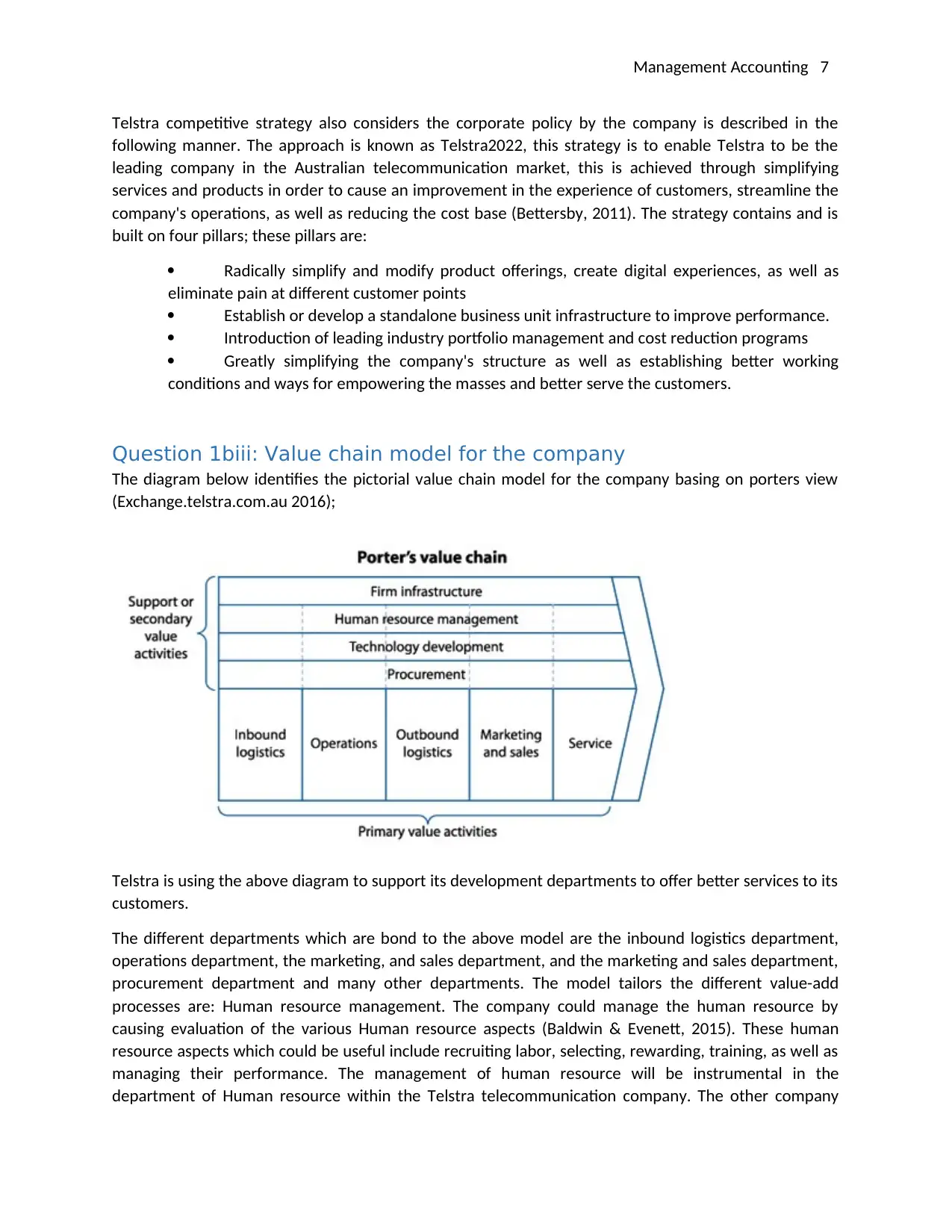
Management Accounting 7
Telstra competitive strategy also considers the corporate policy by the company is described in the
following manner. The approach is known as Telstra2022, this strategy is to enable Telstra to be the
leading company in the Australian telecommunication market, this is achieved through simplifying
services and products in order to cause an improvement in the experience of customers, streamline the
company's operations, as well as reducing the cost base (Bettersby, 2011). The strategy contains and is
built on four pillars; these pillars are:
Radically simplify and modify product offerings, create digital experiences, as well as
eliminate pain at different customer points
Establish or develop a standalone business unit infrastructure to improve performance.
Introduction of leading industry portfolio management and cost reduction programs
Greatly simplifying the company's structure as well as establishing better working
conditions and ways for empowering the masses and better serve the customers.
Question 1biii: Value chain model for the company
The diagram below identifies the pictorial value chain model for the company basing on porters view
(Exchange.telstra.com.au 2016);
Telstra is using the above diagram to support its development departments to offer better services to its
customers.
The different departments which are bond to the above model are the inbound logistics department,
operations department, the marketing, and sales department, and the marketing and sales department,
procurement department and many other departments. The model tailors the different value-add
processes are: Human resource management. The company could manage the human resource by
causing evaluation of the various Human resource aspects (Baldwin & Evenett, 2015). These human
resource aspects which could be useful include recruiting labor, selecting, rewarding, training, as well as
managing their performance. The management of human resource will be instrumental in the
department of Human resource within the Telstra telecommunication company. The other company
Telstra competitive strategy also considers the corporate policy by the company is described in the
following manner. The approach is known as Telstra2022, this strategy is to enable Telstra to be the
leading company in the Australian telecommunication market, this is achieved through simplifying
services and products in order to cause an improvement in the experience of customers, streamline the
company's operations, as well as reducing the cost base (Bettersby, 2011). The strategy contains and is
built on four pillars; these pillars are:
Radically simplify and modify product offerings, create digital experiences, as well as
eliminate pain at different customer points
Establish or develop a standalone business unit infrastructure to improve performance.
Introduction of leading industry portfolio management and cost reduction programs
Greatly simplifying the company's structure as well as establishing better working
conditions and ways for empowering the masses and better serve the customers.
Question 1biii: Value chain model for the company
The diagram below identifies the pictorial value chain model for the company basing on porters view
(Exchange.telstra.com.au 2016);
Telstra is using the above diagram to support its development departments to offer better services to its
customers.
The different departments which are bond to the above model are the inbound logistics department,
operations department, the marketing, and sales department, and the marketing and sales department,
procurement department and many other departments. The model tailors the different value-add
processes are: Human resource management. The company could manage the human resource by
causing evaluation of the various Human resource aspects (Baldwin & Evenett, 2015). These human
resource aspects which could be useful include recruiting labor, selecting, rewarding, training, as well as
managing their performance. The management of human resource will be instrumental in the
department of Human resource within the Telstra telecommunication company. The other company
Paraphrase This Document
Need a fresh take? Get an instant paraphrase of this document with our AI Paraphraser
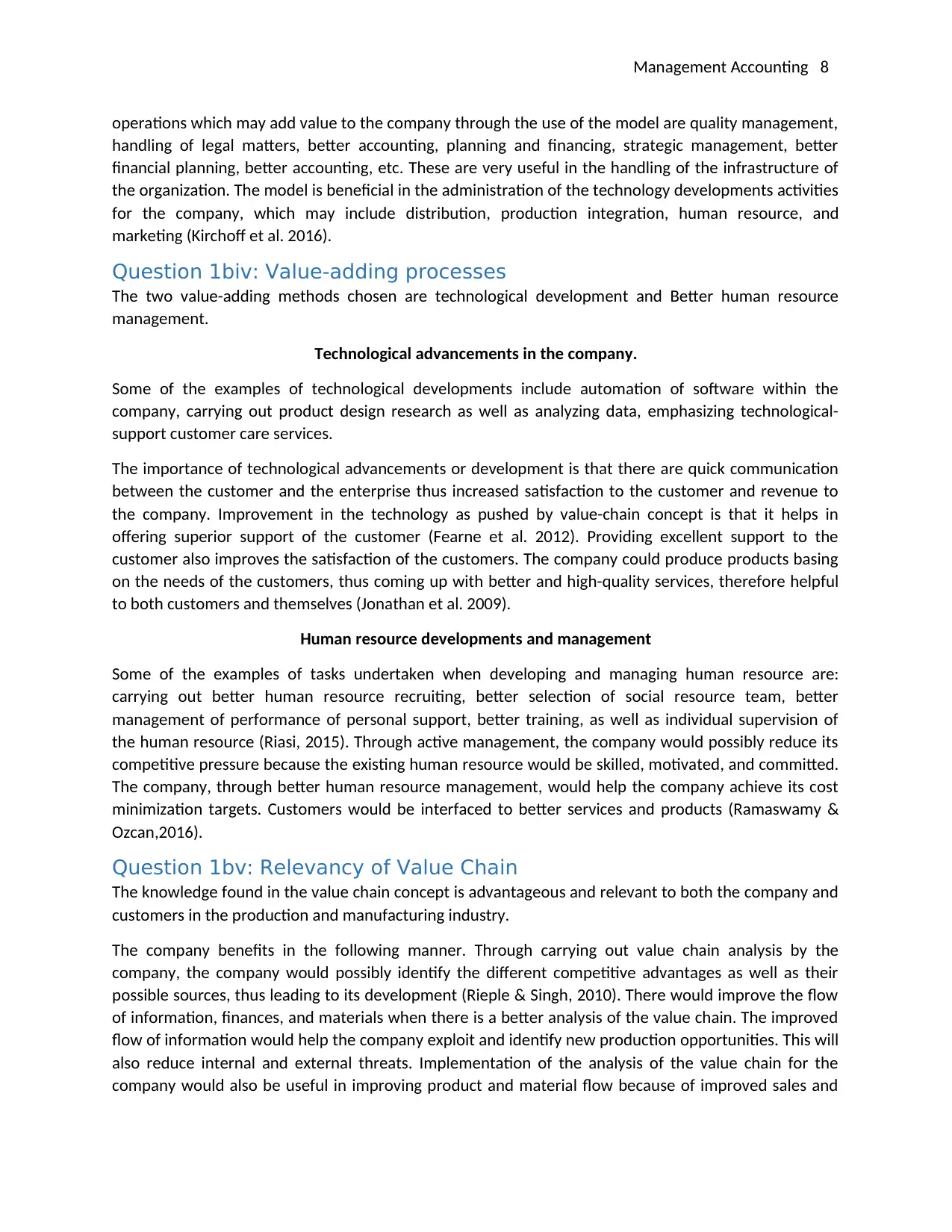
Management Accounting 8
operations which may add value to the company through the use of the model are quality management,
handling of legal matters, better accounting, planning and financing, strategic management, better
financial planning, better accounting, etc. These are very useful in the handling of the infrastructure of
the organization. The model is beneficial in the administration of the technology developments activities
for the company, which may include distribution, production integration, human resource, and
marketing (Kirchoff et al. 2016).
Question 1biv: Value-adding processes
The two value-adding methods chosen are technological development and Better human resource
management.
Technological advancements in the company.
Some of the examples of technological developments include automation of software within the
company, carrying out product design research as well as analyzing data, emphasizing technological-
support customer care services.
The importance of technological advancements or development is that there are quick communication
between the customer and the enterprise thus increased satisfaction to the customer and revenue to
the company. Improvement in the technology as pushed by value-chain concept is that it helps in
offering superior support of the customer (Fearne et al. 2012). Providing excellent support to the
customer also improves the satisfaction of the customers. The company could produce products basing
on the needs of the customers, thus coming up with better and high-quality services, therefore helpful
to both customers and themselves (Jonathan et al. 2009).
Human resource developments and management
Some of the examples of tasks undertaken when developing and managing human resource are:
carrying out better human resource recruiting, better selection of social resource team, better
management of performance of personal support, better training, as well as individual supervision of
the human resource (Riasi, 2015). Through active management, the company would possibly reduce its
competitive pressure because the existing human resource would be skilled, motivated, and committed.
The company, through better human resource management, would help the company achieve its cost
minimization targets. Customers would be interfaced to better services and products (Ramaswamy &
Ozcan,2016).
Question 1bv: Relevancy of Value Chain
The knowledge found in the value chain concept is advantageous and relevant to both the company and
customers in the production and manufacturing industry.
The company benefits in the following manner. Through carrying out value chain analysis by the
company, the company would possibly identify the different competitive advantages as well as their
possible sources, thus leading to its development (Rieple & Singh, 2010). There would improve the flow
of information, finances, and materials when there is a better analysis of the value chain. The improved
flow of information would help the company exploit and identify new production opportunities. This will
also reduce internal and external threats. Implementation of the analysis of the value chain for the
company would also be useful in improving product and material flow because of improved sales and
operations which may add value to the company through the use of the model are quality management,
handling of legal matters, better accounting, planning and financing, strategic management, better
financial planning, better accounting, etc. These are very useful in the handling of the infrastructure of
the organization. The model is beneficial in the administration of the technology developments activities
for the company, which may include distribution, production integration, human resource, and
marketing (Kirchoff et al. 2016).
Question 1biv: Value-adding processes
The two value-adding methods chosen are technological development and Better human resource
management.
Technological advancements in the company.
Some of the examples of technological developments include automation of software within the
company, carrying out product design research as well as analyzing data, emphasizing technological-
support customer care services.
The importance of technological advancements or development is that there are quick communication
between the customer and the enterprise thus increased satisfaction to the customer and revenue to
the company. Improvement in the technology as pushed by value-chain concept is that it helps in
offering superior support of the customer (Fearne et al. 2012). Providing excellent support to the
customer also improves the satisfaction of the customers. The company could produce products basing
on the needs of the customers, thus coming up with better and high-quality services, therefore helpful
to both customers and themselves (Jonathan et al. 2009).
Human resource developments and management
Some of the examples of tasks undertaken when developing and managing human resource are:
carrying out better human resource recruiting, better selection of social resource team, better
management of performance of personal support, better training, as well as individual supervision of
the human resource (Riasi, 2015). Through active management, the company would possibly reduce its
competitive pressure because the existing human resource would be skilled, motivated, and committed.
The company, through better human resource management, would help the company achieve its cost
minimization targets. Customers would be interfaced to better services and products (Ramaswamy &
Ozcan,2016).
Question 1bv: Relevancy of Value Chain
The knowledge found in the value chain concept is advantageous and relevant to both the company and
customers in the production and manufacturing industry.
The company benefits in the following manner. Through carrying out value chain analysis by the
company, the company would possibly identify the different competitive advantages as well as their
possible sources, thus leading to its development (Rieple & Singh, 2010). There would improve the flow
of information, finances, and materials when there is a better analysis of the value chain. The improved
flow of information would help the company exploit and identify new production opportunities. This will
also reduce internal and external threats. Implementation of the analysis of the value chain for the
company would also be useful in improving product and material flow because of improved sales and
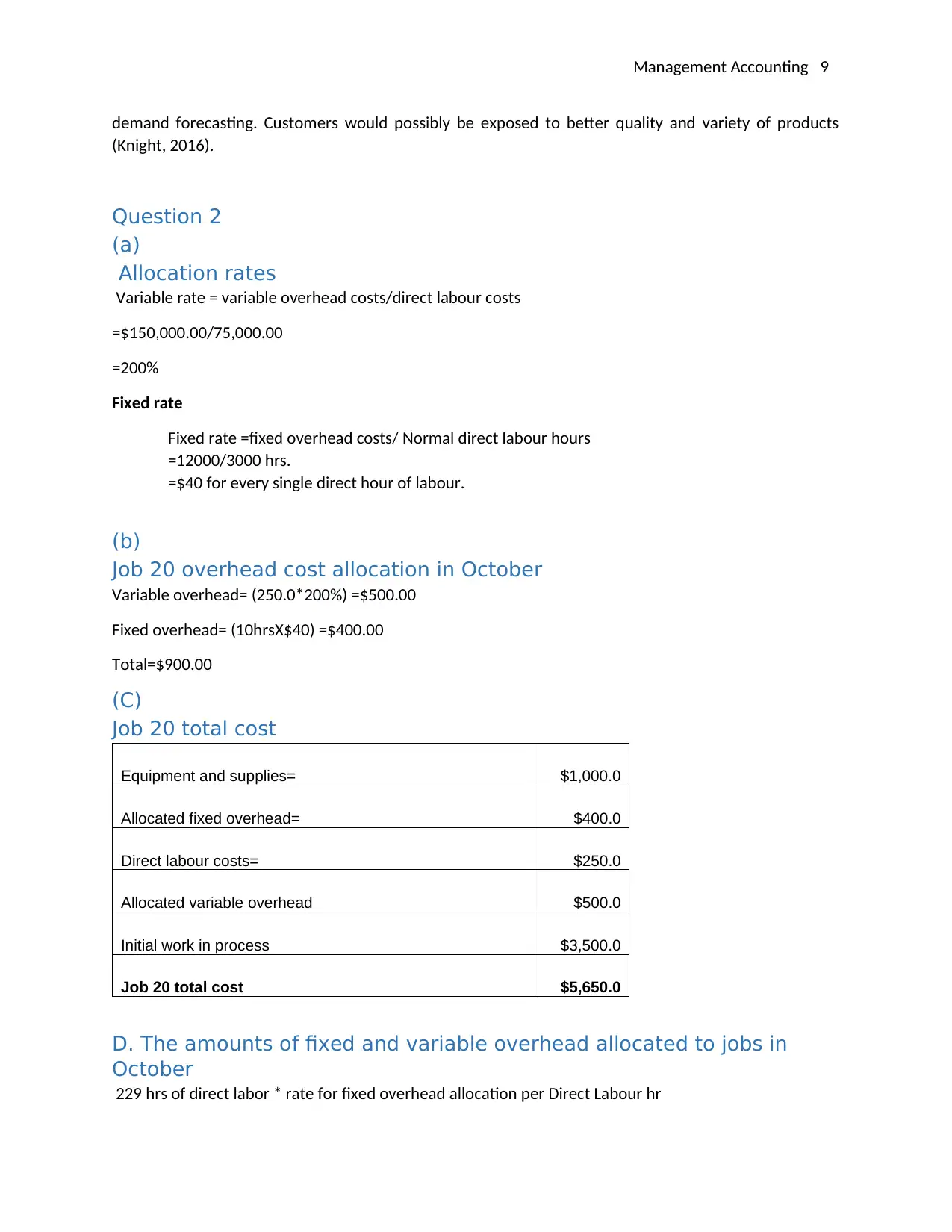
Management Accounting 9
demand forecasting. Customers would possibly be exposed to better quality and variety of products
(Knight, 2016).
Question 2
(a)
Allocation rates
Variable rate = variable overhead costs/direct labour costs
=$150,000.00/75,000.00
=200%
Fixed rate
Fixed rate =fixed overhead costs/ Normal direct labour hours
=12000/3000 hrs.
=$40 for every single direct hour of labour.
(b)
Job 20 overhead cost allocation in October
Variable overhead= (250.0*200%) =$500.00
Fixed overhead= (10hrsX$40) =$400.00
Total=$900.00
(C)
Job 20 total cost
Equipment and supplies= $1,000.0
Allocated fixed overhead= $400.0
Direct labour costs= $250.0
Allocated variable overhead $500.0
Initial work in process $3,500.0
Job 20 total cost $5,650.0
D. The amounts of fixed and variable overhead allocated to jobs in
October
229 hrs of direct labor * rate for fixed overhead allocation per Direct Labour hr
demand forecasting. Customers would possibly be exposed to better quality and variety of products
(Knight, 2016).
Question 2
(a)
Allocation rates
Variable rate = variable overhead costs/direct labour costs
=$150,000.00/75,000.00
=200%
Fixed rate
Fixed rate =fixed overhead costs/ Normal direct labour hours
=12000/3000 hrs.
=$40 for every single direct hour of labour.
(b)
Job 20 overhead cost allocation in October
Variable overhead= (250.0*200%) =$500.00
Fixed overhead= (10hrsX$40) =$400.00
Total=$900.00
(C)
Job 20 total cost
Equipment and supplies= $1,000.0
Allocated fixed overhead= $400.0
Direct labour costs= $250.0
Allocated variable overhead $500.0
Initial work in process $3,500.0
Job 20 total cost $5,650.0
D. The amounts of fixed and variable overhead allocated to jobs in
October
229 hrs of direct labor * rate for fixed overhead allocation per Direct Labour hr
⊘ This is a preview!⊘
Do you want full access?
Subscribe today to unlock all pages.

Trusted by 1+ million students worldwide
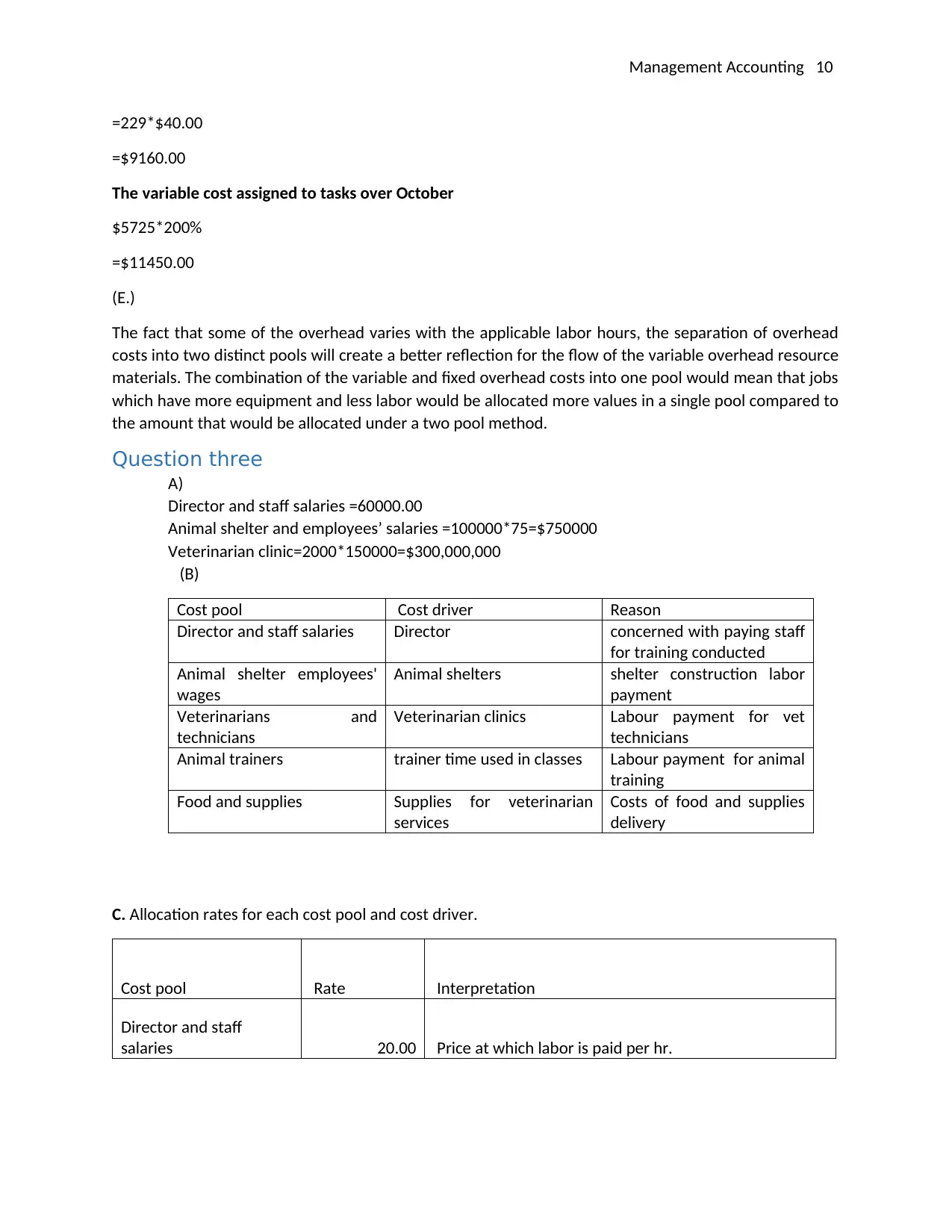
Management Accounting 10
=229*$40.00
=$9160.00
The variable cost assigned to tasks over October
$5725*200%
=$11450.00
(E.)
The fact that some of the overhead varies with the applicable labor hours, the separation of overhead
costs into two distinct pools will create a better reflection for the flow of the variable overhead resource
materials. The combination of the variable and fixed overhead costs into one pool would mean that jobs
which have more equipment and less labor would be allocated more values in a single pool compared to
the amount that would be allocated under a two pool method.
Question three
A)
Director and staff salaries =60000.00
Animal shelter and employees’ salaries =100000*75=$750000
Veterinarian clinic=2000*150000=$300,000,000
(B)
Cost pool Cost driver Reason
Director and staff salaries Director concerned with paying staff
for training conducted
Animal shelter employees'
wages
Animal shelters shelter construction labor
payment
Veterinarians and
technicians
Veterinarian clinics Labour payment for vet
technicians
Animal trainers trainer time used in classes Labour payment for animal
training
Food and supplies Supplies for veterinarian
services
Costs of food and supplies
delivery
C. Allocation rates for each cost pool and cost driver.
Cost pool Rate Interpretation
Director and staff
salaries 20.00 Price at which labor is paid per hr.
=229*$40.00
=$9160.00
The variable cost assigned to tasks over October
$5725*200%
=$11450.00
(E.)
The fact that some of the overhead varies with the applicable labor hours, the separation of overhead
costs into two distinct pools will create a better reflection for the flow of the variable overhead resource
materials. The combination of the variable and fixed overhead costs into one pool would mean that jobs
which have more equipment and less labor would be allocated more values in a single pool compared to
the amount that would be allocated under a two pool method.
Question three
A)
Director and staff salaries =60000.00
Animal shelter and employees’ salaries =100000*75=$750000
Veterinarian clinic=2000*150000=$300,000,000
(B)
Cost pool Cost driver Reason
Director and staff salaries Director concerned with paying staff
for training conducted
Animal shelter employees'
wages
Animal shelters shelter construction labor
payment
Veterinarians and
technicians
Veterinarian clinics Labour payment for vet
technicians
Animal trainers trainer time used in classes Labour payment for animal
training
Food and supplies Supplies for veterinarian
services
Costs of food and supplies
delivery
C. Allocation rates for each cost pool and cost driver.
Cost pool Rate Interpretation
Director and staff
salaries 20.00 Price at which labor is paid per hr.
Paraphrase This Document
Need a fresh take? Get an instant paraphrase of this document with our AI Paraphraser
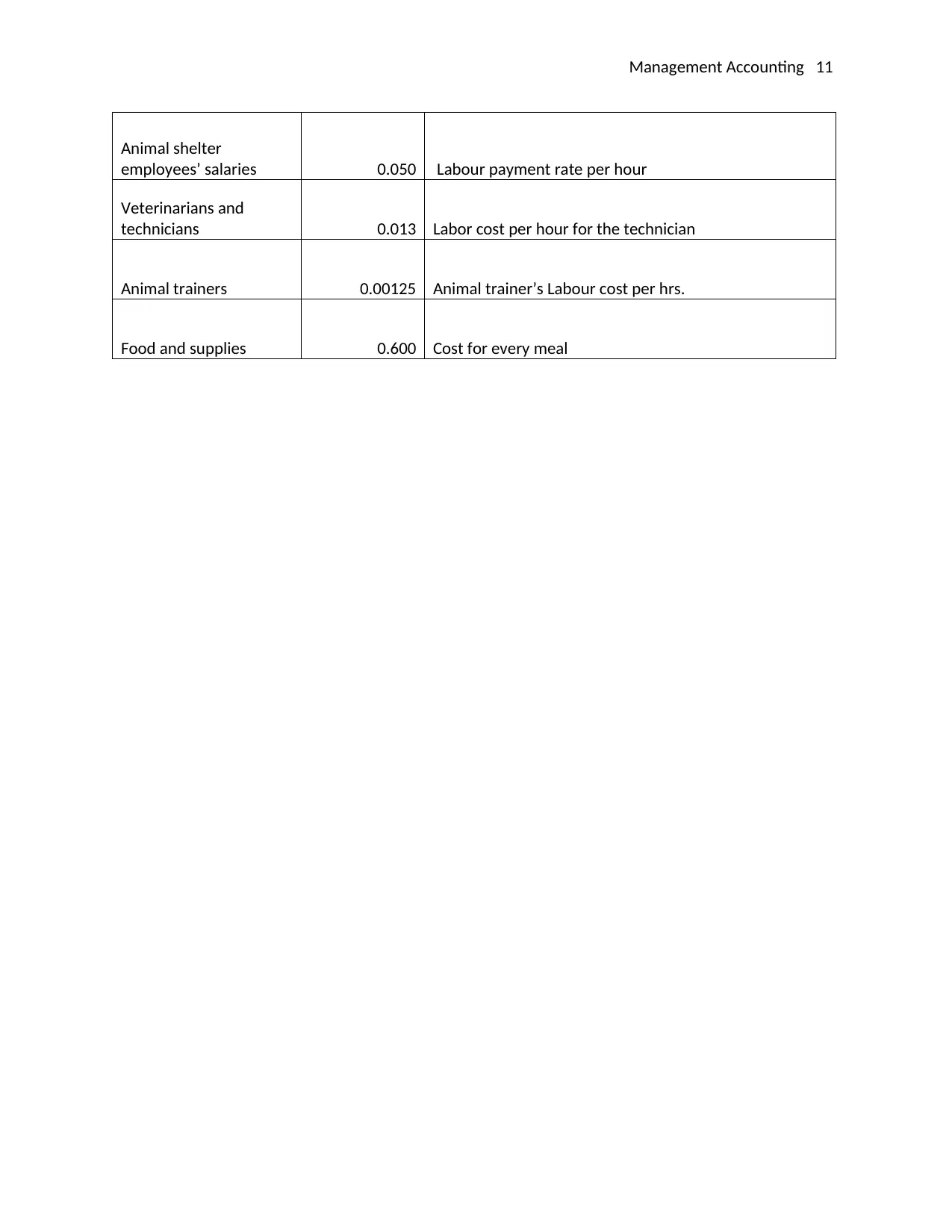
Management Accounting 11
Animal shelter
employees’ salaries 0.050 Labour payment rate per hour
Veterinarians and
technicians 0.013 Labor cost per hour for the technician
Animal trainers 0.00125 Animal trainer’s Labour cost per hrs.
Food and supplies 0.600 Cost for every meal
Animal shelter
employees’ salaries 0.050 Labour payment rate per hour
Veterinarians and
technicians 0.013 Labor cost per hour for the technician
Animal trainers 0.00125 Animal trainer’s Labour cost per hrs.
Food and supplies 0.600 Cost for every meal
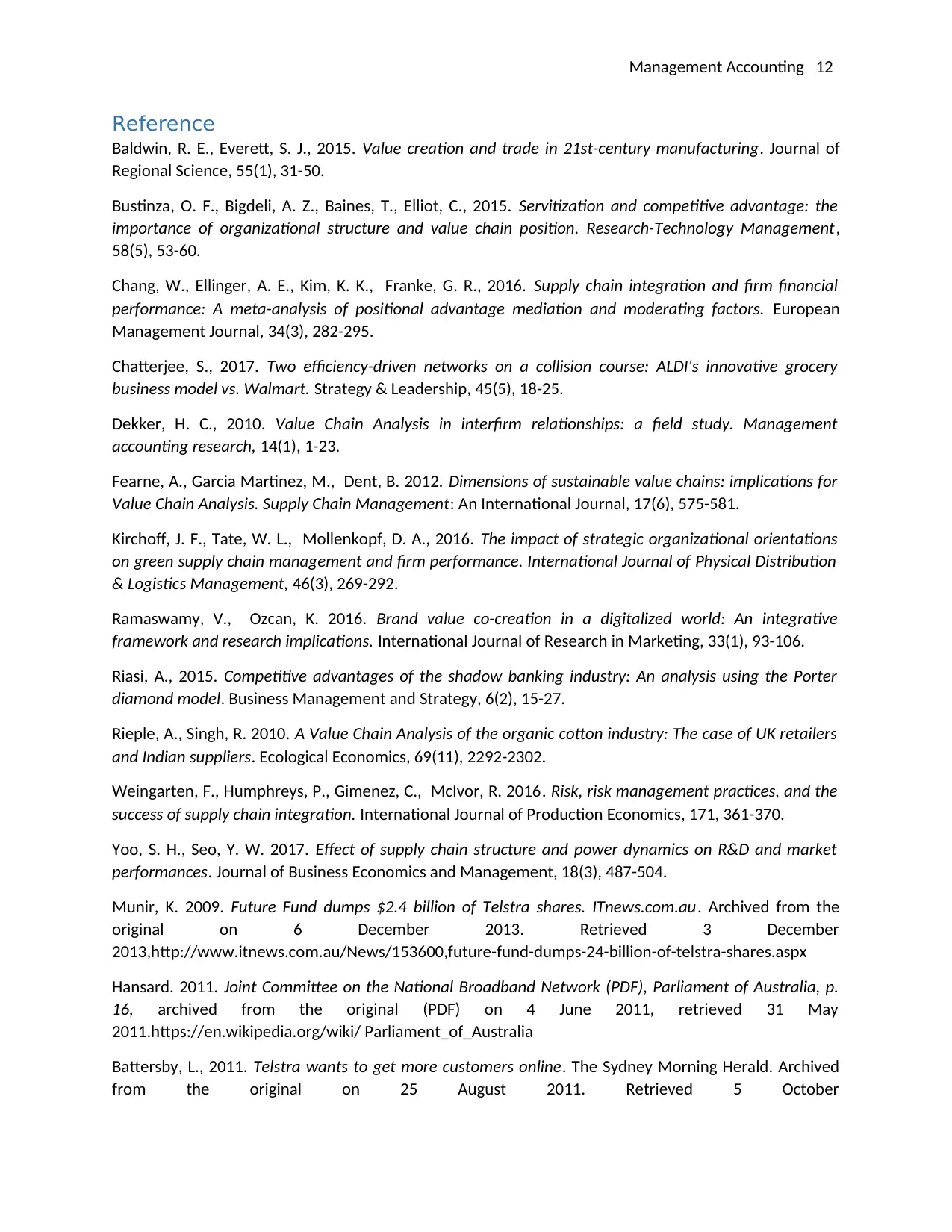
Management Accounting 12
Reference
Baldwin, R. E., Everett, S. J., 2015. Value creation and trade in 21st-century manufacturing. Journal of
Regional Science, 55(1), 31-50.
Bustinza, O. F., Bigdeli, A. Z., Baines, T., Elliot, C., 2015. Servitization and competitive advantage: the
importance of organizational structure and value chain position. Research-Technology Management,
58(5), 53-60.
Chang, W., Ellinger, A. E., Kim, K. K., Franke, G. R., 2016. Supply chain integration and firm financial
performance: A meta-analysis of positional advantage mediation and moderating factors. European
Management Journal, 34(3), 282-295.
Chatterjee, S., 2017. Two efficiency-driven networks on a collision course: ALDI's innovative grocery
business model vs. Walmart. Strategy & Leadership, 45(5), 18-25.
Dekker, H. C., 2010. Value Chain Analysis in interfirm relationships: a field study. Management
accounting research, 14(1), 1-23.
Fearne, A., Garcia Martinez, M., Dent, B. 2012. Dimensions of sustainable value chains: implications for
Value Chain Analysis. Supply Chain Management: An International Journal, 17(6), 575-581.
Kirchoff, J. F., Tate, W. L., Mollenkopf, D. A., 2016. The impact of strategic organizational orientations
on green supply chain management and firm performance. International Journal of Physical Distribution
& Logistics Management, 46(3), 269-292.
Ramaswamy, V., Ozcan, K. 2016. Brand value co-creation in a digitalized world: An integrative
framework and research implications. International Journal of Research in Marketing, 33(1), 93-106.
Riasi, A., 2015. Competitive advantages of the shadow banking industry: An analysis using the Porter
diamond model. Business Management and Strategy, 6(2), 15-27.
Rieple, A., Singh, R. 2010. A Value Chain Analysis of the organic cotton industry: The case of UK retailers
and Indian suppliers. Ecological Economics, 69(11), 2292-2302.
Weingarten, F., Humphreys, P., Gimenez, C., McIvor, R. 2016. Risk, risk management practices, and the
success of supply chain integration. International Journal of Production Economics, 171, 361-370.
Yoo, S. H., Seo, Y. W. 2017. Effect of supply chain structure and power dynamics on R&D and market
performances. Journal of Business Economics and Management, 18(3), 487-504.
Munir, K. 2009. Future Fund dumps $2.4 billion of Telstra shares. ITnews.com.au. Archived from the
original on 6 December 2013. Retrieved 3 December
2013,http://www.itnews.com.au/News/153600,future-fund-dumps-24-billion-of-telstra-shares.aspx
Hansard. 2011. Joint Committee on the National Broadband Network (PDF), Parliament of Australia, p.
16, archived from the original (PDF) on 4 June 2011, retrieved 31 May
2011.https://en.wikipedia.org/wiki/ Parliament_of_Australia
Battersby, L., 2011. Telstra wants to get more customers online. The Sydney Morning Herald. Archived
from the original on 25 August 2011. Retrieved 5 October
Reference
Baldwin, R. E., Everett, S. J., 2015. Value creation and trade in 21st-century manufacturing. Journal of
Regional Science, 55(1), 31-50.
Bustinza, O. F., Bigdeli, A. Z., Baines, T., Elliot, C., 2015. Servitization and competitive advantage: the
importance of organizational structure and value chain position. Research-Technology Management,
58(5), 53-60.
Chang, W., Ellinger, A. E., Kim, K. K., Franke, G. R., 2016. Supply chain integration and firm financial
performance: A meta-analysis of positional advantage mediation and moderating factors. European
Management Journal, 34(3), 282-295.
Chatterjee, S., 2017. Two efficiency-driven networks on a collision course: ALDI's innovative grocery
business model vs. Walmart. Strategy & Leadership, 45(5), 18-25.
Dekker, H. C., 2010. Value Chain Analysis in interfirm relationships: a field study. Management
accounting research, 14(1), 1-23.
Fearne, A., Garcia Martinez, M., Dent, B. 2012. Dimensions of sustainable value chains: implications for
Value Chain Analysis. Supply Chain Management: An International Journal, 17(6), 575-581.
Kirchoff, J. F., Tate, W. L., Mollenkopf, D. A., 2016. The impact of strategic organizational orientations
on green supply chain management and firm performance. International Journal of Physical Distribution
& Logistics Management, 46(3), 269-292.
Ramaswamy, V., Ozcan, K. 2016. Brand value co-creation in a digitalized world: An integrative
framework and research implications. International Journal of Research in Marketing, 33(1), 93-106.
Riasi, A., 2015. Competitive advantages of the shadow banking industry: An analysis using the Porter
diamond model. Business Management and Strategy, 6(2), 15-27.
Rieple, A., Singh, R. 2010. A Value Chain Analysis of the organic cotton industry: The case of UK retailers
and Indian suppliers. Ecological Economics, 69(11), 2292-2302.
Weingarten, F., Humphreys, P., Gimenez, C., McIvor, R. 2016. Risk, risk management practices, and the
success of supply chain integration. International Journal of Production Economics, 171, 361-370.
Yoo, S. H., Seo, Y. W. 2017. Effect of supply chain structure and power dynamics on R&D and market
performances. Journal of Business Economics and Management, 18(3), 487-504.
Munir, K. 2009. Future Fund dumps $2.4 billion of Telstra shares. ITnews.com.au. Archived from the
original on 6 December 2013. Retrieved 3 December
2013,http://www.itnews.com.au/News/153600,future-fund-dumps-24-billion-of-telstra-shares.aspx
Hansard. 2011. Joint Committee on the National Broadband Network (PDF), Parliament of Australia, p.
16, archived from the original (PDF) on 4 June 2011, retrieved 31 May
2011.https://en.wikipedia.org/wiki/ Parliament_of_Australia
Battersby, L., 2011. Telstra wants to get more customers online. The Sydney Morning Herald. Archived
from the original on 25 August 2011. Retrieved 5 October
⊘ This is a preview!⊘
Do you want full access?
Subscribe today to unlock all pages.

Trusted by 1+ million students worldwide
1 out of 13
Related Documents
Your All-in-One AI-Powered Toolkit for Academic Success.
+13062052269
info@desklib.com
Available 24*7 on WhatsApp / Email
![[object Object]](/_next/static/media/star-bottom.7253800d.svg)
Unlock your academic potential
Copyright © 2020–2025 A2Z Services. All Rights Reserved. Developed and managed by ZUCOL.





